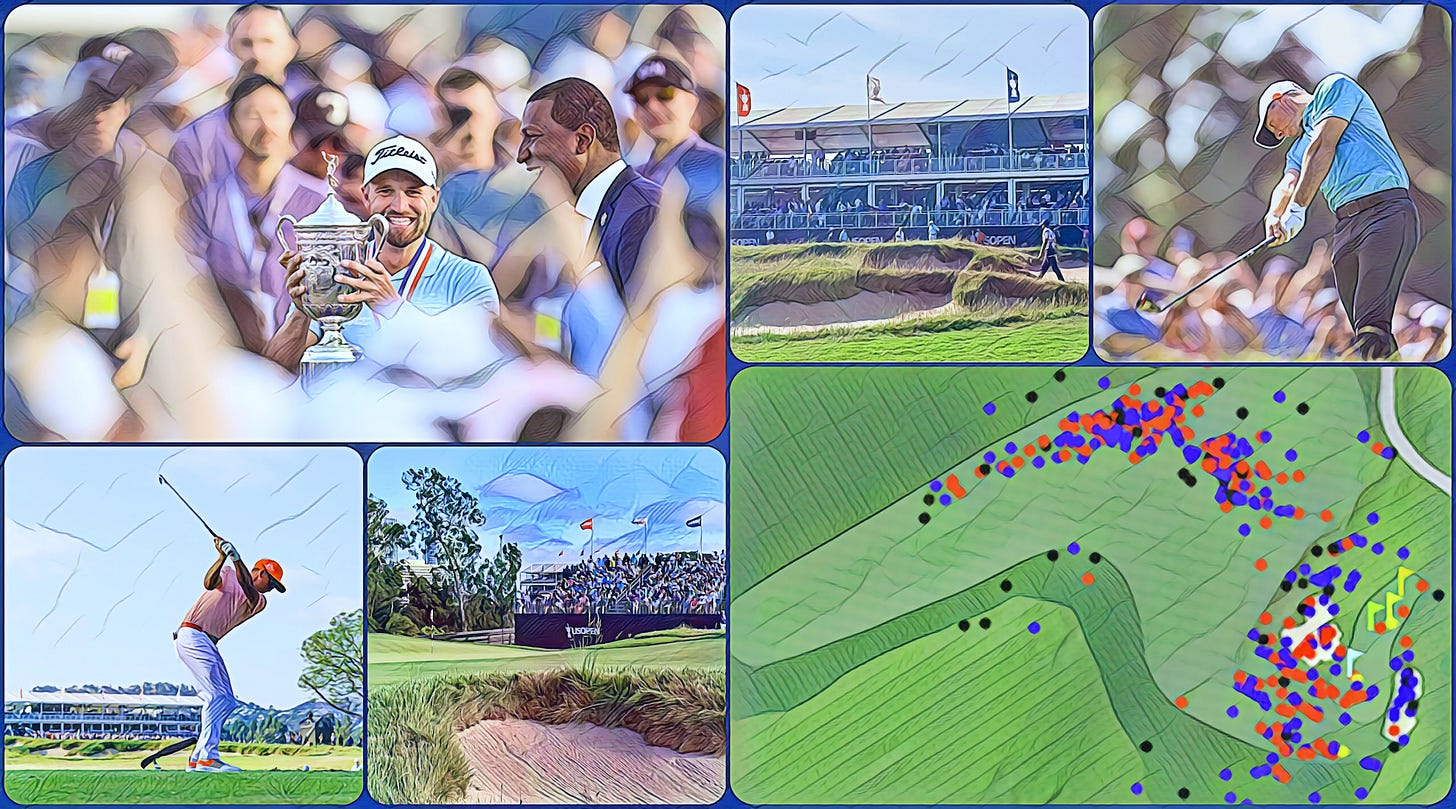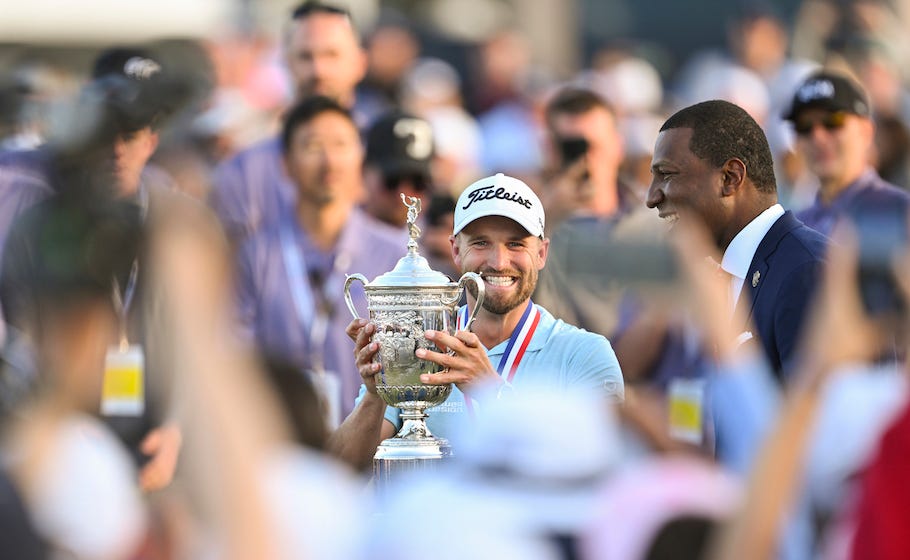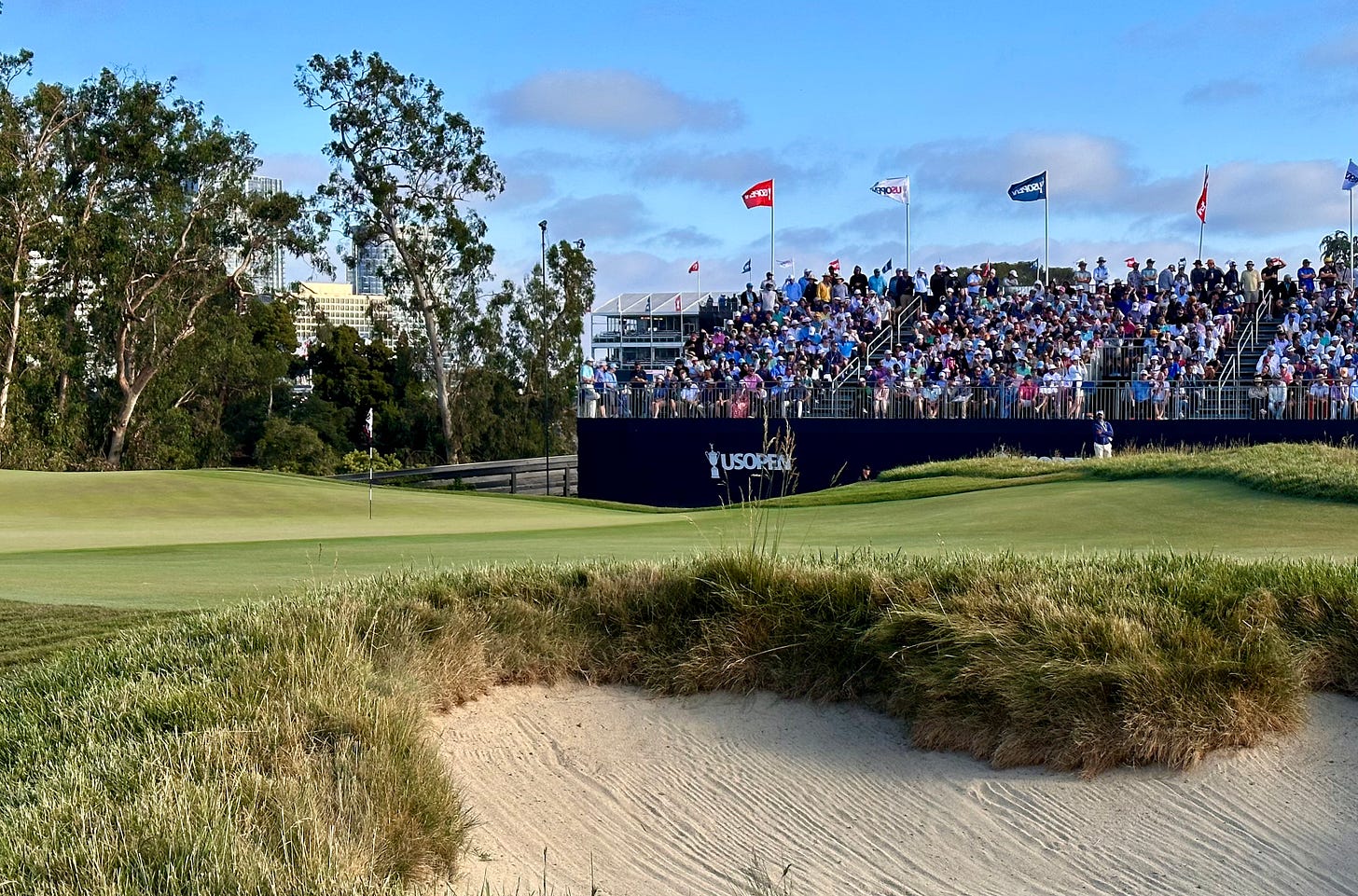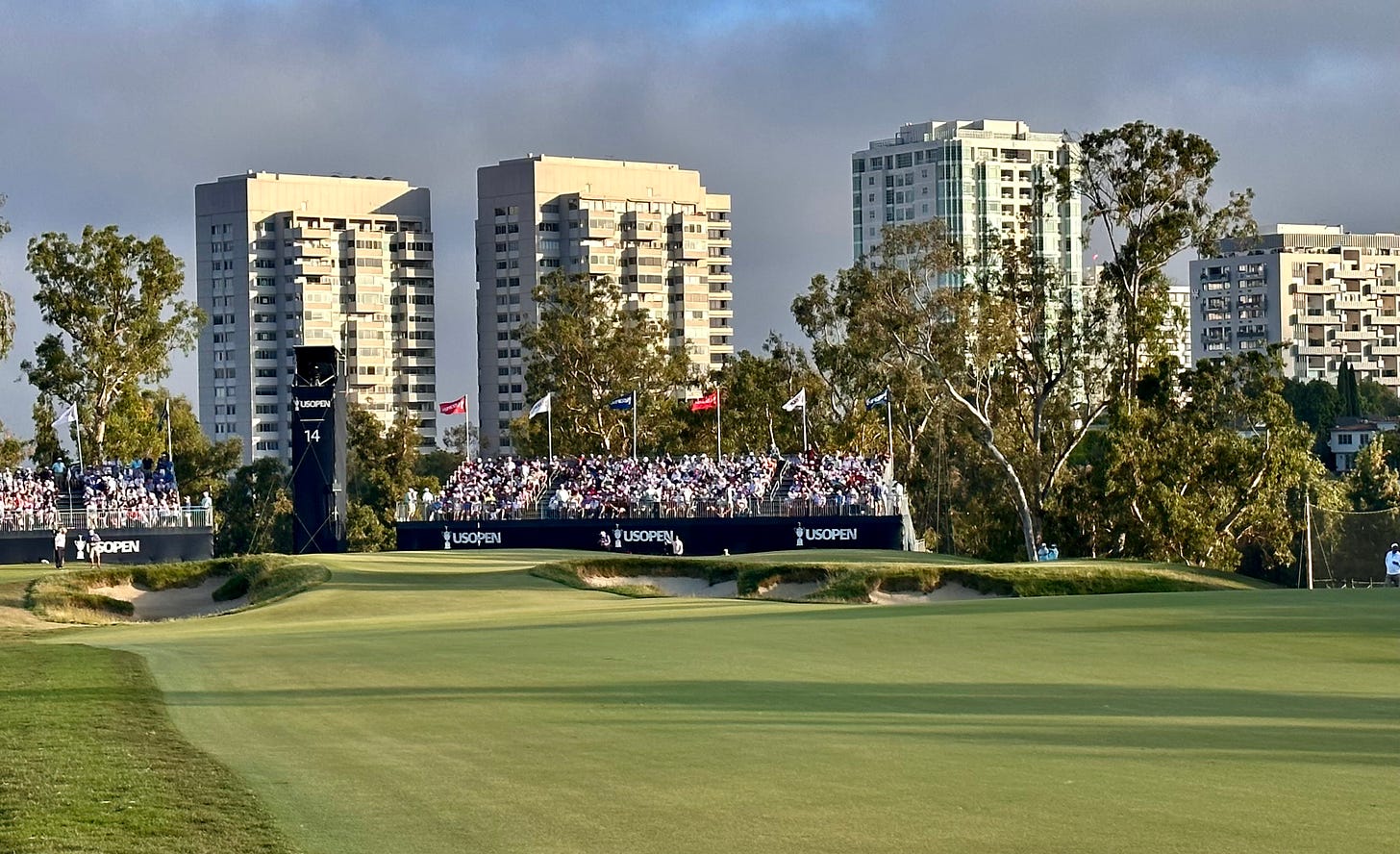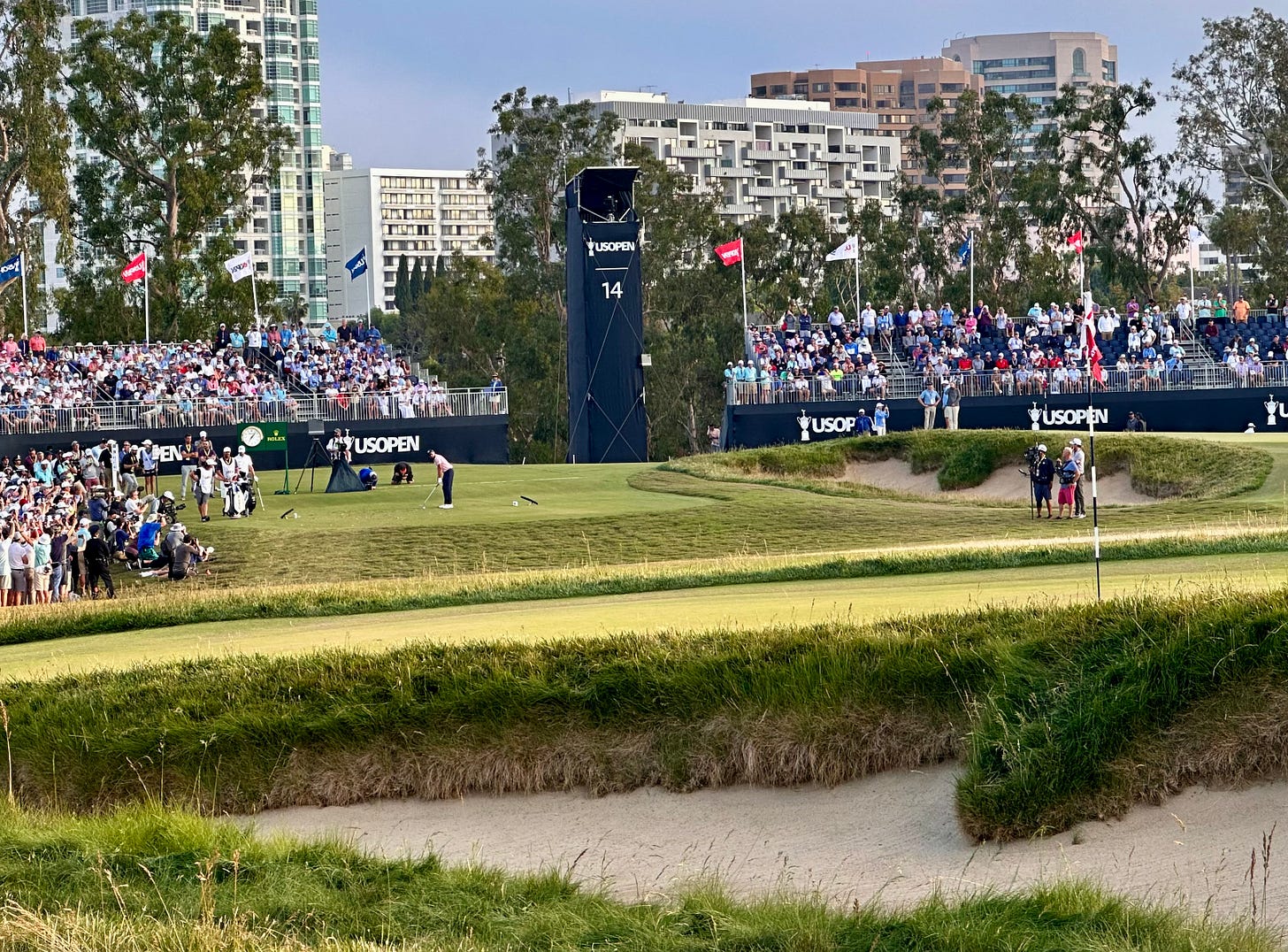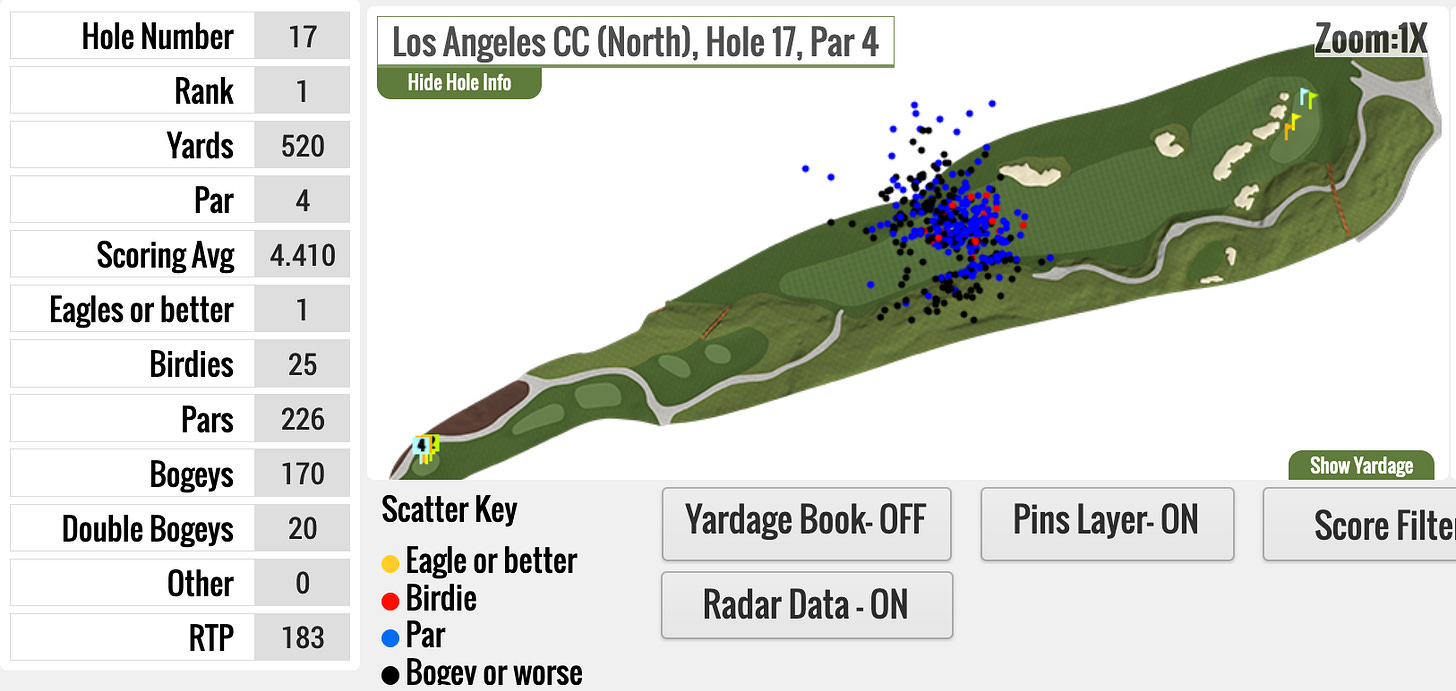2023 U.S. Open Champions, Cutmakers And (Point) Missers
The winners, losers and somewhere in between from the 123rd in Los Angeles.
Plenty to unpack on this one!
The Quadrilateral’s traditional roundup of winners, losers and somewhere in between from the 123rd U.S. Open at Los Angeles Country Club.
Champions
Wyndham Clark. He arrived early, convinced himself the course fit his emerging game, didn’t whine about blind shots or 65 yard wide fairways that were easily holdable, and best of all, exuded a look of determination no other player seemed to have. Aggressive and bullish can often turn fatal in a U.S. Open but a couple of miraculous up-and-downs Sunday made up for any reckless plays. The 29-year-old used all facets of the game to finish -10 and does not feel like a one-and-done type after offloading the big agency and name instructors to find his swing in the dirt. Maybe that’s why his onions never morphed into shallots down the stretch. And look at the stat line for the week: 19 birdies, 41 pars, 11 bogeys, NO doubles, 2 three-putts. Clark played the difficult par 4’s -4 and the par 5’s -8 to McIlroy’s -5 on the three-shotters. A stunning performance and earned victory.
John Ellis. Clark’s caddie is a former Oregon assistant coach whom he befriended during Clark’s lone season in Eugene. He qualified for a pair of U.S. Opens (2008, 2011) and now can take credit for guiding his man to a major victory. Ellis undoubtedly deserves credit for help Clark maintain his composure under pressure and for so cleverly attacking L.A. North.
Rory McIlroy. Gracious in yet another painful defeat where he played so well over a course he had not seen before Monday, McIlroy’s Sunday was eerily similar to St Andrews last year where the solid, smart and seemingly wise play seemed like what a veteran trying to win another major should do over less experienced competition. Once again, someone else somehow played a touch more aggressively, somehow got up and down from a few impossible spots and seemed weirdly unencumbered in contrast to McIlroy, who knows how hard these are to win. “Wyndham was pretty much rock solid all day, and that was a great two-putt at the last,” the runner-up said Sunday after leading the field in Strokes Gained Off The Tee and Putts per Green In Regulation, usually a pretty deadly combination. Ultimately, a three putt off the fringe at 8 and an understandably aggressive third at the 14th were his undoing. The margins in this stupid came can be so cruel sometimes.
The Greens. Superintendent Chris Wilson’s Pure Distinction bent putted incredibly well despite looking like a minefield if =only seen via NBC’s high contrast, vertical camera positions. At ground level? They never bumped, including late in the day after 156 players and caddies had trampled them. Padraig Harrington declared: “These are probably the best greens we've ever putted on in a major. I'm telling you, these are just a pure bent surface which is beautiful to putt on. If you produce good greens, you're going to get good scoring.”
The North Course. Totally biased here given my role in the work and as the architect’s biographer, but even with all the score complaints ignoring the calm and perfect grooming, it still feels like there is a greater appreciation for the ingeniousness of George Thomas and Billy Bell’s and their execution at L.A. North. (At least with those able to separate the course from the club’s attitude toward the public). The variety of par 3 yardages, the predicted extremes of birdies and bogeys (compared to a normal par-fest), and the sight of players having to think their way around, delivered as hoped. The USGA setup highlighted the design and if they erred, it was on the side of respect ensuring a player showcase and not in an attempt to engineer a score. I couldn’t be more proud with how the North Course was presented and played.
Rickie Fowler. A special week where the resurgent veteran made an unfathomable 18 birdies the first two rounds and 23 total to set a new record. That will go with his 62 (that lasted all of 15 minutes until Xander Schauffele matched him). Saturday’s into-the-dark autograph session reminded why he wuld have been such a popular winner, as was the class shown when things went awry Sunday while playing beside the eventual winner. With Fowler atop the leaderboard for three days, he added enormous intrigue to the tournament and the performance bodes well going forward.
Gordon Sargent. Unlike The Masters where his game looked a little overwhelmed by such a massive stage, the World No. 1 amateur took low honors and looked so solid in the process. The short game looked better and the muted reaction to a brutal break at the 18th—turning 68 into 69—was all class. The upside is outrageous.
Tommy Fleetwood. A bit lost in all of the post tournament analysis was another incredible U.S. Open final round 63 from the Englishman who lost the Sunday prior in Canada. While this one goes with his same final day score at Shinnecock, it more impressive than 2018 given the drenching those greens took after the USGA lost control the day before. On Sunday, LACC’s greens were the firmest agronomist Darin Bevard had measured in his time with the USGA. And for Fleetwood, it could have been better. “Missed a six-footer on the first, missed a five-footer on the last, and then everything in between was really, really good,” Fleetwood said. “I just need to be higher up the leaderboard coming into Sunday and then have another day like today. It's a nice little piece of history.” Hoylake? Here comes a major talent back on form.
14th Hole. A sweeping, 623-yard right-to-left bender that ends with one of the most difficult and ingenious greens on the course, it ended up the key hole at LACC. Sunday’s final round hole location over bunker’s left center lured McIlroy to play an unwise shot at the pin when the slope left could have been used to give him a 10 footer for birdie. That same slope and narrow approach tantalized Clark to hit the shot of the tournament and maybe a lifetime: a 282-yard three wood to set up an eagle putt and massive two shot swing to build a needed cushion ahead of the the treacherous finish. The 14th played to a 5.120 average, making it the toughest par-5 the best men’s professional golfers have seen all year.
Barranca. I wasn’t sure how the scrubby hazard would go over given the excessively tall fine fescue nourished by winter rains, but players seemed to embrace the “maybe, maybe not” element of taking the hazard on. No one complained about the spots unmarked by red penalty area lines which are separate of the main water-moving channel (in the front of 6 and 7). It’s a reminder that either/or hazards are not as interesting as those murkier areas where a recovery might happen.
6th Hole. Things could have gone a lot of ways with this one: blind tee shot, slim green surrounded by dense fescue, and decisions all around. That tends to add up to trouble in a modern game where players label something broken if there is not one clear way to attack. Though the green held better than expected from well back—and players did lay shockingly far back in the fairway more than expected—the scatter chart is pretty dreamy in terms of giving players width and a hole that’s only a 275 yard straight shot holding its own. The dispersion is beautiful, though also perplexing players did not ever try to nudge one down to the very far end for a better angle of attack.
ShotLink. Thank you USGA for moving to the PGA Tour’s system. This shot tracking system is the gold standard when it comes to telling the player and course stories. Now we just need it at The Masters, The Open and the women’s majors.
NBC’s portrayal of the 6th. From the early round explanations by on course reporters helping viewers understand the options, to camera angles from all perspectives, the little drivable gem got the rock star coverage from NBC. This graphic on tee shot lines was fun:
Cutmakers
Jon Rahm. What a nice final round 65 and backdoor T10. But in the week he was at LACC, Rahm seemed too easily irritated and resistant to the challenges posed. Imagine if he’d just mellowed a bit and embraced the challenge two days sooner?
First Tee scene. With corporations taking over the LACC clubhouse, the sight of fat cats combied with Bob Ford’s ho-hum intros and an overall lack of fan energy got rounds off to a flat start. We don’t need Michael Buffer saying “lets get ready to rumble!” But a little more pizzazz would have helped. The U.S. Open first tee used to be one of the great goose bump scenes in golf. Particularly when an upstart turned up in the final groups and fans were there to encourage the little guy. Now it’s all just a little too member-guesty and based on the reactions, the world noticed.
The U.S. Open identity. The USGA’s in a tough spot. Some people just want par to be the winning score with no care in the world how they get there, forgetting how awful things are when the event spills over the top and taints the action with goofy setup tactics. A lesser writer would label this a form of tiny wiener syndrome but The Quad is a family newsletter. Thursday’s first round 62’s brought out the gripes and even the final round 63 by Fleetwood did despite firm greens and tough pins. He tied the low final day score at two pretty nice courses in Oakmont and Shinnecock. So I’ll leave it to McIlroy to some up whether this was a proper U.S. Open. “It’s felt like a U.S. Open all week,” he said after Saturday’s round. “The scoring was surprisingly low over the first couple of days, but it doesn’t look or feel like any of the other three major championships. The U.S. Open has definitely got its own identity, and I think that identity was pretty strong from the opening tee shot on Thursday.”
Fan entrance. Despite record high ticket prices, there was obvious trouble in sending the paying plebeians to deal with the Century City mall ($33) or the Uber drop off area closer to Culver City than the country club. The USGA shuttled LACC members from UCLA parking structures secured years ago while corporate guests were dropped on the South Course, saving them the nearly one mile uphill walk just to see a golf shot. Plenty of fans were just happy to be on the exclusive grounds but plenty more got the message upon seeing the exclusive stands for corporate and members as they were left to find very limited golf viewing. At least the concession prices were reasonable.
WiFi. The Cisco WiFi sort of worked in select areas but overall with the usual reception issues popped up when you put so many people on a property. Just like at the PGA and every other tournament now, the spectators were forced to rely on mobile phones to get scores and pairings. They once again longing for a simple printed pairing sheet when the data could not be pulled up on the phone. Is this really that difficult?
Front nine/back nine difference. The North Course’s front nine features three par-3s and two par-5s, but played nearly 1.4 strokes easier for the week. Every course is different and more than (at least I) expected, it was very much a score-early-and-hang-on exam. Also, the back nine’s lone par-5 ended up playing over par for the week to give an even more hang-on-for-dear-life quality to the incoming holes.
15th Hole. The little 80, 81 or whatever yardage it was Saturday did not produce the same drama as it did during the 2017 Walker Cup. But stroke play is a different beast than match play. The players showed wisdom and restraint in not going at the hole which played beautifully to all hole locations. But given the Saturday cautiousness, perhaps it would have made a better Sunday hole location to wring a little more risk-taking out of the field.
17th Hole. This beauty ended up playing as the most difficult hole with a 4.410 average and was noted by several players for its attractiveness. But it lacked strategic charm with the tee so far back from a fairway bunker 360 yards away that did not come into play. Nor did the fairway opening around the righthand barranca see any action because it could not be reached. It offers a better angle into Sunday’s back left hole location to a rock hard green.
Score grousing. It’s understandable that fans want a certain identity to each major and for the U.S. Open to keep up with its past standards, but given juiced modern equipment and amazing agronomy, it’s tough to engineer difficulty without going all in on goofy. The par-lovers were quite after a “more-U.S. Open-than-the-U.S. Open” PGA Championship was won at Oak Hill with a -9, 271. Yet somehow Wyndham Clark’s -10, 270 appears to have been the source of great consternation even though the last three U.S. Open’s were won at -6 (with LACC having three par-5s, two of which that played like long par 4s). The score complaints are likely a result of the bad taste left by a corporate atmosphere and memories of the day one scoring onslaught producing the first 62’s in U.S. Open history. I get it but I don’t buy it.
West Coast U.S. Opens. NBC devoted more hours to this one than any U.S. Open in history and the network was rewarded with very strong numbers given the sheer volume of coverage. Seeing the hours put in on site by crews, it’s a massive feat just to pull off and maybe too ambitious given some of the coverage gripes. But Saturday’s late finish risked playing under a marine layer and it would only take a ruling or two to slow things down to the point final groups felt like conditions were compromised. And that’s what happened.
The 2023 vs. 2022 ratings courtesy of Showbuzzdaily.com:




